微观经济学原理
微观经济学原理简答题及其参考答案

微观经济学原理简答题及其参考答案一.名词解释1. 需求:消费者在一定时期内在各种可能的价格水平愿意而且能够购买的该商品的数量。
2. 供给:生产者在一定时期内在各种价格水平下愿意并且能够提供出售的该种商品的数量。
3. 均衡价格:一种商品的均衡价格是指该种商品的市场需求量和市场供给量相等时的价格。
4. 需求量的变动和需求的变动:需求量的变动是指在其它条件不变时由某种商品的价格变动所应起的该商品需求数量的变动。
需求的变动是指在某商品价格不变的条件下,由于其它因素变动所引起的该商品需求数量的变动。
5. 供给量的变动和供给的变动:供给量的变动是指在其它条件不变时由某种商品的价格变动所应起的该商品供给数量的变动。
供给的变动是指在某商品价格不变的条件下,由于其它因素变动所引起的该商品供给数量的变动。
6. 弹性:当一个经济变量发生1%的变动时,由它引起的另一个经济变量变动的百分比。
7. 需求的价格弹性:表示在一定时期内一种商品的需求量变动对于该商品的价格变动的反应程度。
或者说,表示在一定时期内当一种商品的价格变化百分之一时所引起的该商品的需求量变化的百分比。
8. 供给的价格弹性:表示在一定时期内一种商品的供给量的变动对于该商品的价格的变动的反应程度。
或者说,表示在一定时期内当一种商品的价格变化百分之一时所引起的该商品的供给量变化的百分比。
9. 需求的交叉价格弹性:表示在一定时期内一种商品的需求量的变动相对于它的相关商品的价格变动的反应程度。
或者说,表示在一定时期内当一种商品的价格变化百分之一时所引起的另一种商品的需求量变化百分比。
10. 替代品:如果两种商品之间能够相互替代以满足消费者的某一种欲望,则称这两种商品之间存在着替代关系,这两种商品互为替代品。
11. 互补品:若两种商品必须同时使用才能满足消费者的某一种欲望,则称这两种商品之间存在着互补关系,这两种商品互为互补品。
12. 需求的收入弹性:需求的收入弹性表示在一定时期内消费者对某种商品的需求量变动对于消费者收入量变动的反应程度。
经济学原理(微观部分)
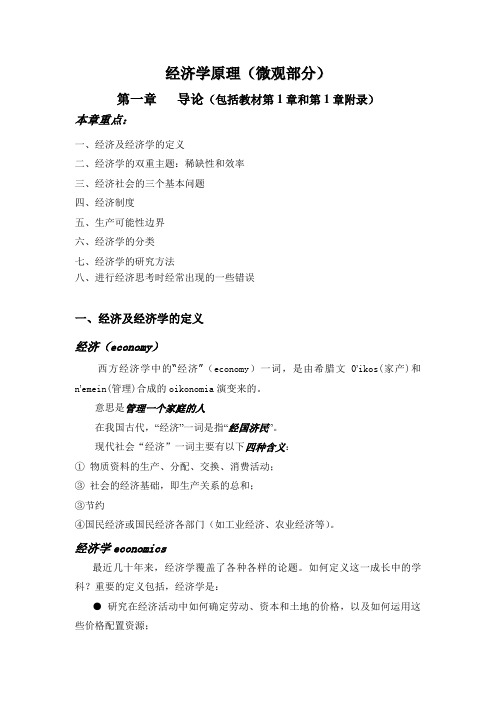
经济学原理(微观部分)第一章导论(包括教材第1章和第1章附录)本章重点:一、经济及经济学的定义二、经济学的双重主题:稀缺性和效率三、经济社会的三个基本问题四、经济制度五、生产可能性边界六、经济学的分类七、经济学的研究方法八、进行经济思考时经常出现的一些错误一、经济及经济学的定义经济(economy)西方经济学中的“经济”(economy)一词,是由希腊文0’ikos(家产)和n’emein(管理)合成的oikonomia演变来的。
意思是管理一个家庭的人在我国古代,“经济”一词是指“经国济民”。
现代社会“经济”一词主要有以下四种含义:①物质资料的生产、分配、交换、消费活动;③社会的经济基础,即生产关系的总和;③节约④国民经济或国民经济各部门(如工业经济、农业经济等)。
经济学economics最近几十年来,经济学覆盖了各种各样的论题。
如何定义这一成长中的学科?重要的定义包括,经济学是:●研究在经济活动中如何确定劳动、资本和土地的价格,以及如何运用这些价格配置资源;●考察金融市场行为,分析金融市场如何将资本配置到其他经济部门;●考察收入分配及如何在不损害经济运行的前提下对穷人给予帮助;●考察政府支出、税收、预算赤字对经济增长有何影响;●考察经济周期中失业与生产的波动,并提出改善经济增长的政策;●考察各国贸易模式并分析贸易壁垒有何影响;●观察发展中国家的发展,并对鼓励资源有效利用的方式提出建议。
如果我们将所有这些定义加以提炼的话,我们就会发现一个共同主题:经济学的定义经济学研究的是社会如何利用稀缺的资源以生产有价值的商品,并将它们分配给不同的个人。
二、经济学的双重主题:稀缺与效率(一)稀缺1、稀缺scarcity稀缺即有限,相对于人类社会的无穷欲望而言,物品或者说生产这些物品所需要的资源总是不足的。
在经济学中,这种资源或物品的相对有限性被称为稀缺性。
教师设问:为什么存在稀缺性呢?❖一定时期内,物品本身是有限的❖一定时期内,利用物品进行生产的技术条件是有限的❖人的生命是有限的如何理解稀缺性呢?❖稀缺性是绝对的、又是相对的。
曼昆微观经济学经济学的十大原理课件
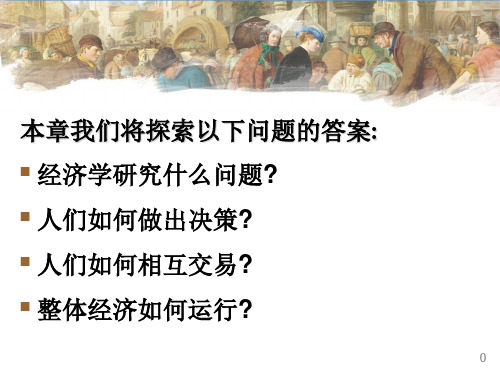
参考资料:如何阅读本书
5. 上网
本书有一个极好的网络资源,包括测试练习, 提高你画图能力的工具,视频以及其它资源 可以帮助你更轻松有效地学习教材。访问网 址:
6. 小组学习 与同学一起复习每个章节,互相测验,互相 帮助理解材料
曼昆微观经济学经济学的十大原理
29
参考资料:如何阅读本书
▪ 教其他人
学习某种东西的最好的方法莫过于再教其 他人, 比如学友或朋友
护和其他需求之间分配资源
曼昆微观经济学经济学的十大原理
2
人们如何做出决策
原理一: 人们面临权衡取舍
所有决策者都面临着权衡取舍。比如:
▪ 参加期中考试前一天晚上的聚会意味着更少
的时间学习
▪ 想要更多的收入需要工作更长时间,这就使
得休息时间减少
▪ 保护环境意味着生产消费物品的资源减少
曼昆微观经济学经济学的十大原理
增长而导致货币价值的下降所引起
▪ 政府创造货币的速度越快,通胀率越高
曼昆微观经济学经济学的十大原理
24
整体经济如何运行
原理 10 :社会面临通货膨胀与失业之间的短期权衡 取舍
货币增加
失业减少
消费支出增加 企业抬高物价
雇佣更多工人 企业抬高物价
曼昆微观经济学经济学的十大原理
25
经济学有用吗?
▪ 蹩脚的经济学或许有害! ▪ 举例:破窗谬论! ▪ 建议:不要做卢德派分子,也不要做保护主
曼昆微观经济学经济学的十大原理
4
人们如何做出决策
原理二: 某种东西的成本是为了得到它所放弃 的东西
▪ 人们做出决策时需要比较可供选择行动方案
的成本与利益
▪ 任何一种东西的机会成本是为了得到这种东
微观经济学原理

微观经济学原理要点整理一、导言1、经济学十大原理①人们面临权衡取舍;②某种东西的成本是为了得到它所放弃的东西;③理性人考虑边际量;④人们会对激励做出反应;⑤贸易可以使每个人的状况都变得更好;⑥市场通常是组织经济活动的一种好方法;⑦政府有时可以改善市场结果;⑧一国的生活水平取决于它的生产物品与劳务的能力;⑨当政府发行了过多货币时,物价上升;⑩社会面临通货膨胀与失业之间的短期权衡取舍。
2、经济学的作用①有助于我们了解我们生活的世界;②使我们更精明地参与经济;③是我们更好地理解经济政策的潜力;④有助于人类反思和约束行为,人与自然和谐相处。
3、定义:研究社会如何管理自己的稀缺资源。
4、起源:中国东晋(舍己为苍生),西方古希腊(家庭个人利益)。
5、经济学思维语言的作用:信息传递、信息储存、思维表现的载体。
思维方式:直觉思维、逻辑思维。
两个模型:循环流量图、生产可能性边界。
6、比较优势、专门化与贸易专门化和贸易的好处不是基于绝对优势,而是相对优势。
贸易可以使社会上每个人都获益,它可以使人们都从事自己有比较优势的活动。
7、名词稀缺性:社会资源的有限性。
平等:经济成果在社会成员中平均分配的特性。
效率:社会能从其稀缺资源中得到最大利益的特性。
理性人:系统而有目的地尽最大努力实现其目标的人。
边际变动:对行动计划的微小变动调整。
激励:引起一个人做出某种行为的某种东西。
市场经济:当许多企业和家庭在物品和劳务市场上相互交易时,通过它们的分散决策配置资源的经济。
产权:个人拥有并控制稀缺资源的能力。
市场失灵:市场本身不能有效配置资源的情况。
外部性:一个人的行为对旁观者福利的影响。
(如污染)市场势力:单个(或一小群)经济活动者对市场价格有显著影响的能力。
生产率:每单位劳动投入所生产的物品与劳务数量。
通货膨胀:经济中物价总水平的上升。
经济周期:就业和生产等经济活动的波动。
生产可能性边界:表示在可得到的生产要素与生产技术既定时,一个经济所能生产的产品数量的各种组合的图形。
微观经济学的十大原理

微观经济学的十大原理
1.人们面临权衡和边际考虑:个体在做出经济决策时需要权衡不同选择之间的利益与成本,并且考虑每个选择的边际效益。
2.机会成本:做出某个选择所放弃的最高价值的替代品,即为机会成本。
3.理性人假设:在经济决策中,个体通常会根据自身的利益最大化进行选择。
4.边际效益递减:随着个体消费或生产的增加,对每个单位增量的边际效益会逐渐减少。
5.交易可以改善福利:通过交易和市场运作,个体可以获得比在自给自足的情况下更多的消费物品和服务。
6.市场的力量:市场机制可以有效地分配资源,通过供求关系决定价格和数量。
7.政府的角色:在某些情况下,政府可能需要干预市场,修正市场失灵或提供公共产品。
8.效率与公平的权衡:经济系统需要平衡效率(资源最有效利用)和公平(资源分配的均衡性)两个目标。
9.刺激性法:政府通过财政政策和货币政策来调整经济活动,以达到稳定经济增长和控制通货膨胀的目标。
10.经济具有长期趋势:长期来看,经济会受到技术进步、人口增长和资源稀缺等因素的影响,经济形势会相应改变。
经济学原理(微观部分)

经济学原理(微观部分)经济学原理是经济学的基础,它是经济学研究的起点。
本篇文章主要介绍经济学原理中的微观经济学部分,主要包括生产者理论、消费者理论和市场均衡。
一、生产者理论生产者理论主要关注生产者如何制定生产计划以达到最大利润。
在生产者理论中,最重要的概念之一是边际成本和边际收益。
边际成本是指生产一个单位所需要的成本,边际收益是指生产一个单位所获得的额外收益。
在制定生产计划时,生产者需要将边际成本与边际收益进行比较,以确定最佳生产水平。
当边际成本等于边际收益时,即达到最大利润的水平。
此时,生产者应该停止增加生产,因为增加生产将导致边际成本大于边际收益,从而导致利润下降。
生产者理论还可以用来解释竞争性市场中的股价的变化。
当制造商收到投资者的信号警告时,由于利润增加,他们将增加生产,导致股价下降。
相反,当投资者感到乐观时,由于利润下降,生产者将减少生产,导致股价上涨。
生产者理论的另一个应用是在制定环保政策时。
在没有任何政府干预的情况下,高污染企业很少会采取降低污染的措施,因为这将增加他们的成本。
政府可以通过征收污染排放费,让高污染企业面临更高的成本,从而激励他们采取措施减少污染。
二、消费者理论消费者理论主要关注消费者如何根据其预算约束选择最佳消费组合。
在约束的情况下,消费者会根据其偏好函数选择最满意的消费组合。
最基本的消费者理论概念是边际效用和收入效应。
边际效用是指消费最后一个单位所提供的额外效用,收入效应是指消费通过改变收入而引起的消费量变化。
当消费者面临收入变化时,他们会根据其边际效用和收入效应调整其消费组合。
在一般情况下,当收入上涨时,消费者会倾向于增加正常商品的消费,并减少相对于其他商品的数量。
相反,当收入下降时,消费者倾向于减少正常商品的消费,增加相对于其他商品的数量。
消费者理论可以用来解释不同市场之间的市场交换价值问题。
市场交换价值是指市场双方获得的总效用。
在供需曲线交叉的地方,市场交换价值达到最大值。
01191《微观经济学原理》-周彩艳
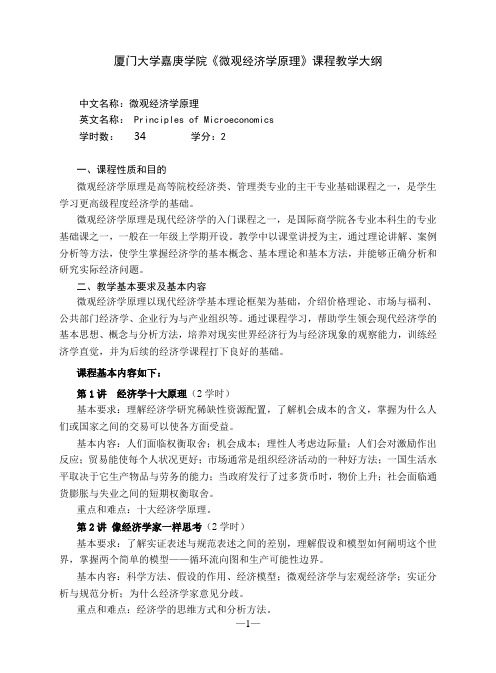
厦门大学嘉庚学院《微观经济学原理》课程教学大纲中文名称:微观经济学原理英文名称: Principles of Microeconomics学时数: 34 学分:2一、课程性质和目的微观经济学原理是高等院校经济类、管理类专业的主干专业基础课程之一,是学生学习更高级程度经济学的基础。
微观经济学原理是现代经济学的入门课程之一,是国际商学院各专业本科生的专业基础课之一,一般在一年级上学期开设。
教学中以课堂讲授为主,通过理论讲解、案例分析等方法,使学生掌握经济学的基本概念、基本理论和基本方法,并能够正确分析和研究实际经济问题。
二、教学基本要求及基本内容微观经济学原理以现代经济学基本理论框架为基础,介绍价格理论、市场与福利、公共部门经济学、企业行为与产业组织等。
通过课程学习,帮助学生领会现代经济学的基本思想、概念与分析方法,培养对现实世界经济行为与经济现象的观察能力,训练经济学直觉,并为后续的经济学课程打下良好的基础。
课程基本内容如下:第1讲经济学十大原理(2学时)基本要求:理解经济学研究稀缺性资源配置,了解机会成本的含义,掌握为什么人们或国家之间的交易可以使各方面受益。
基本内容:人们面临权衡取舍;机会成本;理性人考虑边际量;人们会对激励作出反应;贸易能使每个人状况更好;市场通常是组织经济活动的一种好方法;一国生活水平取决于它生产物品与劳务的能力;当政府发行了过多货币时,物价上升;社会面临通货膨胀与失业之间的短期权衡取舍。
重点和难点:十大经济学原理。
第2讲像经济学家一样思考(2学时)基本要求:了解实证表述与规范表述之间的差别,理解假设和模型如何阐明这个世界,掌握两个简单的模型——循环流向图和生产可能性边界。
基本内容:科学方法、假设的作用、经济模型;微观经济学与宏观经济学;实证分析与规范分析;为什么经济学家意见分歧。
重点和难点:经济学的思维方式和分析方法。
第3讲相互依存性与贸易的好处(2学时)基本要求:了解绝对优势与比较优势的含义,理解比较优势如何解释贸易的好处,掌握把比较优势理论运用于日常生活和国家政策。
微观经济学第一章经济学的十大原理

替代效应
替代效应
替代效应是指当某一物品的价格发生变化时,消费者会用相对便宜的物品替代相对昂贵的 物品,以降低自身消费的成本。
替代效应的原理
替代效应的原理基于消费者对价格变动的反应。当某一物品的价格下降时,消费者会倾向 于增加对该物品的消费,而减少对相对昂贵物品的消费;反之,当某一物品的价格上升时 ,消费者会减少对该物品的消费,转而寻找其他替代品。
全球化对发展中国家尤为重要,因为它们可以通过参与国 际贸易和投资,获得资金、技术和市场,促进本国经济的 发展。同时,全球化也带来了挑战,如经济波动、竞争压 力等,需要各国加强合作与协调,共同应对挑战。
03
政府有时可以改善市场结果
市场失灵
外部性
市场无法解决外部性, 如污染、噪音等,需要 政府通过法规和政策进
05
在长期,竞争市场将产生有 效产出
市场结构对产出和价格的影响
完全竞争市场
垄断市场
寡头市场
垄断竞争市场
在完全竞争市场中,单个生 产者无法影响市场价格,只 能接受市场价格。这种情况 下,生产者为了追求利润最 大化,将产量调整至边际成 本等于边际收益的点,这个 产量就是有效产出。
垄断市场结构下,由于只有 一个生产者,它可以自行设 定价格和产量。这种情况下 ,垄断者可能会通过限制产 量来提高价格,导致市场产 出低于完全竞争市场的有效 产出。
02 03
机会成本的意义
了解机会成本有助于人们更加明智地做出决策,避免做出低效或错误的 决策。通过考虑机会成本,人们可以更加全面地评估自己的选择,从而 做出更符合自身利益和资源最优配置的决策。
机会成本的计算
机会成本的计算涉及到对放弃的选项进行比较和评估。在计算机会成本 时,需要考虑到放弃的选项中价值最大的一个,并将其作为机会成本。
微观经济学原理

微观经济学原理
微观经济学原理是一种用来研究市场经济结构、操作和效果的学科。
它是由少数个体、单位和超过群体行为组成,用来研究个体和市场的行为。
主要原理有:
1、供求理论:供求是经济活动的基础,决定商品价格的基本原理是供求的平衡,描述的是一种对市场的装填性、价格和产量的调节影响。
2、最优决策:它是每个个体根据给定的目标、可用资源和准则,以最大化收益或最小化成本为目标,做出的有效决策。
3、有效效用:该理论认为,每个个体具有独特的偏好和风险承受能力,基于客观自身的效用函数,对收益进行有效调整和决策,以期获取最优的结果。
4、熵理论:指的是根据各类偏好条件来求取最优结果的理论。
它的核心思想是要根据消费者的先验偏好,来衡量消费者对具有不同偏好得到的收益和产量的最大和最小偏好。
5、回报权衡:这是只考虑当下期望收益,忽略对未来期望收益的考虑,只要今天收益大于固定成本,就把它认为是经济上可行的行为。
6、货币配置:它是指根据财务能力,采取有效调整财务资源的策略,以增加财务资源的利用效率和降低投资成本。
7、生产与分配:生产活动是分配资源的基础,分配资源的周期是循环的,可提高分配效率的成本低的策略和技术是完善分配的基础,促进生产和分配的活动。
微观经济学原理是市场经济的基本原理,也是得出经济行为结果的基础,它从单个个体和群体的行为出发,为经济分析、模型提出挑战,为经济发展提供新的解决方案。
因此,微观经济学原理的实施和发展对经济的发展具有重要的意义。
微观经济学的原理和应用
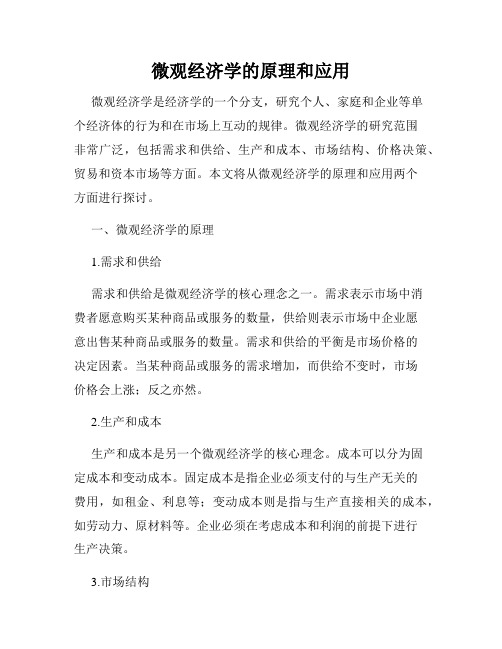
微观经济学的原理和应用微观经济学是经济学的一个分支,研究个人、家庭和企业等单个经济体的行为和在市场上互动的规律。
微观经济学的研究范围非常广泛,包括需求和供给、生产和成本、市场结构、价格决策、贸易和资本市场等方面。
本文将从微观经济学的原理和应用两个方面进行探讨。
一、微观经济学的原理1.需求和供给需求和供给是微观经济学的核心理念之一。
需求表示市场中消费者愿意购买某种商品或服务的数量,供给则表示市场中企业愿意出售某种商品或服务的数量。
需求和供给的平衡是市场价格的决定因素。
当某种商品或服务的需求增加,而供给不变时,市场价格会上涨;反之亦然。
2.生产和成本生产和成本是另一个微观经济学的核心理念。
成本可以分为固定成本和变动成本。
固定成本是指企业必须支付的与生产无关的费用,如租金、利息等;变动成本则是指与生产直接相关的成本,如劳动力、原材料等。
企业必须在考虑成本和利润的前提下进行生产决策。
3.市场结构市场结构是指市场中的市场份额、市场竞争力等。
根据市场结构的不同可以分为完全竞争市场、垄断市场、垄断竞争市场和寡头垄断市场。
市场结构的变化会对市场价格和供给产生影响。
4.贸易和资本市场贸易和资本市场是微观经济学另外两个重要的研究领域。
在贸易市场中,国家之间的贸易活动会对经济产生影响,例如资源配置和就业等。
在资本市场中,投资者通过买卖股票和债券等证券来实现资产增值。
二、微观经济学的应用微观经济学具有广泛的应用价值,不仅是企业家、政策制定者、学者甚至是普通消费者都能够从中受益。
下面是几个微观经济学的应用场景和案例。
1. 定价策略定价策略是企业家日常经营中最需要关注的问题之一。
由于市场竞争的存在,定价的制定往往不仅仅是成本的考虑,还需要考虑市场需求的弹性和竞争压力。
例如,当需求弹性较高时,企业需要灵活调整价格,以避免萎缩;当市场竞争力较弱时,企业可以适当提高价格以提高利润。
在此过程中,企业需要了解市场的需求和竞争环境,获得微观经济学的知识是非常重要的。
微观经济学十大原理
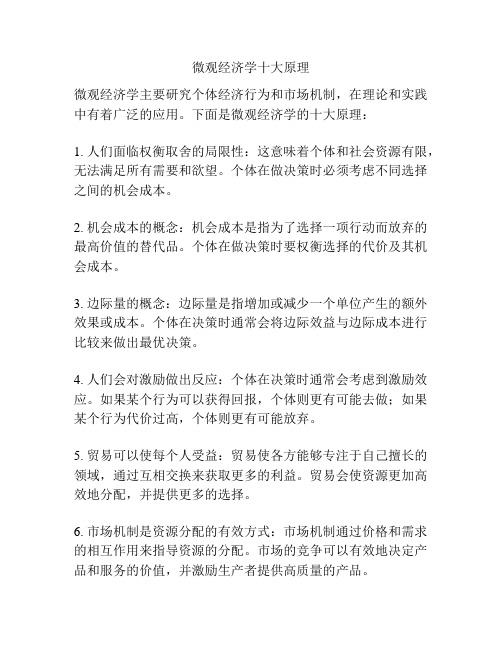
微观经济学十大原理微观经济学主要研究个体经济行为和市场机制,在理论和实践中有着广泛的应用。
下面是微观经济学的十大原理:1. 人们面临权衡取舍的局限性:这意味着个体和社会资源有限,无法满足所有需要和欲望。
个体在做决策时必须考虑不同选择之间的机会成本。
2. 机会成本的概念:机会成本是指为了选择一项行动而放弃的最高价值的替代品。
个体在做决策时要权衡选择的代价及其机会成本。
3. 边际量的概念:边际量是指增加或减少一个单位产生的额外效果或成本。
个体在决策时通常会将边际效益与边际成本进行比较来做出最优决策。
4. 人们会对激励做出反应:个体在决策时通常会考虑到激励效应。
如果某个行为可以获得回报,个体则更有可能去做;如果某个行为代价过高,个体则更有可能放弃。
5. 贸易可以使每个人受益:贸易使各方能够专注于自己擅长的领域,通过互相交换来获取更多的利益。
贸易会使资源更加高效地分配,并提供更多的选择。
6. 市场机制是资源分配的有效方式:市场机制通过价格和需求的相互作用来指导资源的分配。
市场的竞争可以有效地决定产品和服务的价值,并激励生产者提供高质量的产品。
7. 政府可以改善市场结果:尽管市场机制可以有效地分配资源,但有时政府可以介入来纠正市场失灵。
政府可以通过制定规则和监管来保护消费者权益、维护公平竞争和解决外部性问题。
8. 价格上升导致需求下降:价格和需求之间存在反向关系。
当价格上涨时,需求量减少;当价格下跌时,需求量增加。
这种关系被称为供求关系。
9. 市场机制可以治愈短缺:当某种商品供应不足时,价格会上升,激励生产者增加供应量。
同样地,当某种商品供过于求时,价格会下跌,激励消费者增加需求。
10. 政府对市场的干预可能会引发副作用:政府干预市场时应审慎考虑,因为干预可能会引发意外的后果。
政府的政策可能导致资源分配的扭曲和市场失灵。
微观经济学的以上十大原理是理解个体决策和市场机制的基础。
了解这些原理可以帮助我们更好地理解经济的运作方式,并做出明智的决策。
微观经济学原理

微观经济学原理微观经济学是研究个体经济行为和市场机制的学科领域,它揭示了经济系统中个体与个体之间的相互作用,以及市场供求关系对资源配置和价格形成的影响。
本文将探讨微观经济学的基本原理及其应用。
一、稀缺性原理稀缺性原理是微观经济学的基本出发点,它认为资源是有限的,而人们的欲望是无穷的。
由于资源有限,无法满足所有需求,因此个体和社会必须面临取舍和选择。
个体在面临选择时,会根据自身的利益和需求来做出决策。
二、效用最大化原理个体在做出决策时,会追求效用最大化。
效用是个体对商品或服务的满足程度,个体会选择使自己获得最大效用的组合。
效用最大化的原则也称为“边际效用递减原理”,即个体在消费一个单位的商品或服务时,其边际效用会递减。
三、供给和需求供给和需求是市场经济中的重要概念。
供给是指生产者愿意出售的商品或服务的数量,而需求是指消费者愿意购买的商品或服务的数量。
供给和需求的关系决定了市场价格和数量的形成。
当供给大于需求时,价格会下降;当需求大于供给时,价格会上升。
四、边际分析原理边际分析原理是微观经济学的重要工具,它研究个体在做出决策时,对边际变动的反应。
边际变动指的是多增加(或减少)一单位的某项资源对效用或成本的影响。
个体在做出决策时,会考虑边际收益与边际成本的比较,以决定是否继续增加或减少某项资源的使用。
五、市场失灵市场失灵指供给和需求无法有效地决定资源配置和价格形成,从而导致资源的浪费或分配不均。
常见的市场失灵包括外部性、公共物品和垄断等。
外部性是指市场行为给不参与市场交易的第三方带来的影响,如环境污染。
公共物品是指无法通过市场交换来提供的商品或服务,如国防和公共道路。
垄断是指市场上只有一个卖家或少数几个卖家垄断了市场,导致价格过高和供应不足。
六、市场竞争市场竞争是效率经济体系的基础。
市场竞争可以提供更多的选择,促进资源的有效配置,并通过竞争机制来推动创新和提高产品质量。
竞争市场的特征包括自由进出、充分信息、无完全垄断等。
微观经济学十大原理
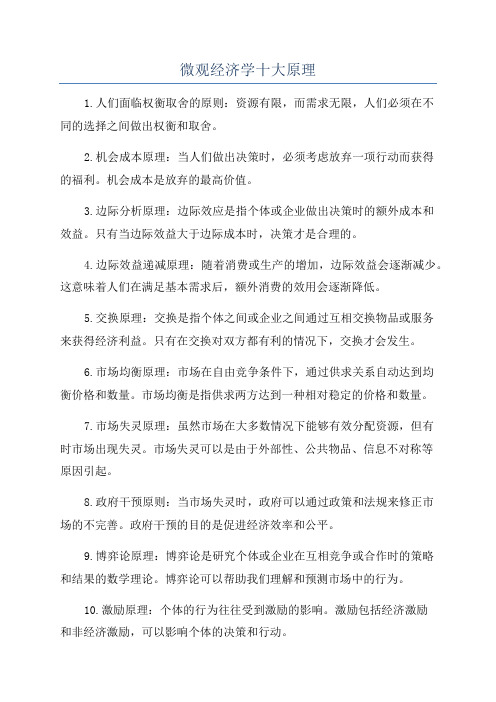
微观经济学十大原理1.人们面临权衡取舍的原则:资源有限,而需求无限,人们必须在不同的选择之间做出权衡和取舍。
2.机会成本原理:当人们做出决策时,必须考虑放弃一项行动而获得的福利。
机会成本是放弃的最高价值。
3.边际分析原理:边际效应是指个体或企业做出决策时的额外成本和效益。
只有当边际效益大于边际成本时,决策才是合理的。
4.边际效益递减原理:随着消费或生产的增加,边际效益会逐渐减少。
这意味着人们在满足基本需求后,额外消费的效用会逐渐降低。
5.交换原理:交换是指个体之间或企业之间通过互相交换物品或服务来获得经济利益。
只有在交换对双方都有利的情况下,交换才会发生。
6.市场均衡原理:市场在自由竞争条件下,通过供求关系自动达到均衡价格和数量。
市场均衡是指供求两方达到一种相对稳定的价格和数量。
7.市场失灵原理:虽然市场在大多数情况下能够有效分配资源,但有时市场出现失灵。
市场失灵可以是由于外部性、公共物品、信息不对称等原因引起。
8.政府干预原则:当市场失灵时,政府可以通过政策和法规来修正市场的不完善。
政府干预的目的是促进经济效率和公平。
9.博弈论原理:博弈论是研究个体或企业在互相竞争或合作时的策略和结果的数学理论。
博弈论可以帮助我们理解和预测市场中的行为。
10.激励原理:个体的行为往往受到激励的影响。
激励包括经济激励和非经济激励,可以影响个体的决策和行动。
这些原理提供了理解个体、家庭和企业在资源稀缺条件下作出决策的框架。
通过研究这些原理,我们可以更好地理解和解释经济现象,并为政策制定者提供指导。
微观经济学的原理也是学习其他经济学领域的基础,如宏观经济学和发展经济学。
微观经济学五大基本原理

在完全竞争市场上,买卖双方人数都很多, 在完全竞争市场上,买卖双方人数都很多,每个 厂商的产量占整个市场的产量很小, 厂商的产量占整个市场的产量很小,于是每个厂 商的产量增加对于整个市场供给的影响不大, 商的产量增加对于整个市场供给的影响不大,因 此难以影响到市场价格。 此难以影响到市场价格。这时候每个厂商都是市 场价格的接受者。 场价格的接受者。 在垄断市场上,只有一个厂商, 在垄断市场上,只有一个厂商,厂商可以根据消 费者的需求制定不同的价格,实行价格歧视。 费者的需求制定不同的价格,实行价格歧视。
原理三: 原理三:利益相互影响原理
1.人与人的利益相互作用相互影响。所有人的利 人与人的利益相互作用相互影响。 人与人的利益相互作用相互影响 益是由所有人的行为共同决定的。 益是由所有人的行为共同决定的。每个人的行为 决策不仅影响到他自己的利益, 决策不仅影响到他自己的利益,而且影响到他人 的利益。用公式表示就是: 的利益。用公式表示就是: 设世界上有n个人 符号设为k=1,2,…,n。设人 个人, 设世界上有 个人,符号设为 。 们的利益为U,行为为a,那么有: 们的利益为 ,行为为 ,那么有: Uk=Uk(a1,a2,…,an),k=1,2,…,n , 但是由于不同的人们之间相互影响的程度有大有 因此,为了研究的简化, 小,因此,为了研究的简化,通常忽略那些相互 之间较小的影响,而主要研究那些较大的影响。 之间较小的影响,而主要研究那些较大的影响。
微观经济学 五大原理
淮海工学院 王智慧 witswang@
原理一:代价需要定律(张五常) 原理一:代价需要定律(张五常)
获得一种商品的价价越大,则需求越小; 获得一种商品的价价越大,则需求越小;获得一 种商品的代价越小,则需求越大。 种商品的代价越小,则需求越大。
经济学原理曼昆微观经济_概述及解释说明

经济学原理曼昆微观经济概述及解释说明1. 引言1.1 概述经济学原理曼昆微观经济是一门研究个体经济行为和市场机制的学科,通过对供求关系、价格形成、利润最大化等核心概念的解析和应用,揭示了市场经济中的运行规律和决策制定的基本原则。
本文将对经济学原理曼昆微观经济进行概述及解释说明,介绍其定义、研究对象与方法,以及在实际应用中的重要性和领域。
1.2 文章结构本文共分为五个部分:引言、经济学原理曼昆微观经济概述、解释说明微观经济学原理曼昆的要点、应用案例分析和结论。
在引言部分,我们将介绍文章的背景和目的;在第二部分,我们将对经济学原理曼昆微观经济进行详细概述;第三部分将解释说明该书中所包含的要点;第四部分将通过实际应用案例进行深入分析;最后,在结论部分再次强调该书在现实生活中的重要性,并给出总结和展望。
1.3 目的本文旨在全面介绍和解释经济学原理曼昆微观经济的核心概念和理论框架,以帮助读者更好地理解市场经济中的个体行为、供求关系以及价格形成机制。
通过应用案例分析,我们将探讨市场失灵与政府干预的影响、企业竞争策略与市场效率关系,以及个人决策、消费者行为对社会福利的影响。
最终,本文旨在强调经济学原理曼昆微观经济在实际生活中的重要性,并展望其未来发展方向。
2. 经济学原理曼昆微观经济概述2.1 定义和基本概念:经济学原理曼昆微观经济指的是在经济学原理中,对微观经济学进行的研究与分析。
微观经济学是一门研究个体(家庭、企业或市场)如何做出决策,以及这些决策对资源配置和价格形成方式的影响的学科。
它关注个体行为背后的动机和机制,并通过建立各种模型来帮助解释和预测市场行为。
2.2 微观经济学的研究对象和方法:微观经济学主要研究个体间的相互作用以及它们在市场上买卖商品和服务所涉及的决策过程。
而其研究方法主要使用了供求分析、边际分析、均衡价格分析等工具。
供求分析用于研究市场上买方和卖方之间产品数量和价格之间的关系,以此来解释市场行为。
微观经济学十大原理

微观经济学十大原理微观经济学是研究个体经济行为及其相互关系的学科,它揭示了许多经济现象背后的原理和规律。
在微观经济学中,有许多重要的原理,它们帮助我们更好地理解经济活动和市场行为。
本文将介绍微观经济学的十大原理,希望能够帮助读者更好地理解微观经济学的基本概念和原理。
首先,供求原理是微观经济学中最基本的原理之一。
它指出了市场价格和商品数量之间的关系,即当商品供应增加时,价格下降;当商品供应减少时,价格上升。
这一原理帮助我们理解市场价格是如何形成的,以及为什么一些商品的价格会随着时间的推移而发生变化。
其次,边际原理是微观经济学中的重要概念。
它指出了个体在决策时应该考虑边际成本和边际收益,即在做出决策时应该比较额外投入所带来的额外产出。
这一原理帮助我们理解为什么人们会在某个时刻做出某种决策,以及为什么人们会在某个时刻停止做出某种决策。
第三,机会成本原理是微观经济学中的重要概念之一。
它指出了在做出决策时,我们需要考虑放弃某种选择所带来的机会成本,即我们需要考虑放弃某种选择所损失的其他选择机会。
这一原理帮助我们理解为什么在资源有限的情况下,我们需要做出选择,以及为什么我们需要在不同选择之间进行权衡。
第四,市场效率原理是微观经济学中的重要原理之一。
它指出了在竞争市场中,市场会自动调整,使资源得到最有效的配置。
这一原理帮助我们理解为什么竞争市场能够有效配置资源,以及为什么市场干预可能会导致资源配置的失调。
第五,市场失灵原理是微观经济学中的重要概念。
它指出了在某些情况下,市场机制可能会导致资源配置的失调,需要政府进行干预。
这一原理帮助我们理解为什么有些市场无法有效配置资源,以及为什么政府需要进行干预来解决市场失灵问题。
第六,外部性原理是微观经济学中的重要概念之一。
它指出了在市场交易中,可能会产生对其他人产生影响的外部效应,这些外部效应可能会导致资源配置的失调。
这一原理帮助我们理解为什么市场交易可能会对其他人产生影响,以及为什么需要政府进行干预来解决外部性问题。
微观经济学原理(第七版) 曼昆 名词解释(带英文)

微观经济学原理曼昆名词解释稀缺性(scarcity):社会资源的有限性。
经济学(economics):研究社会如何管理自己的稀缺资源。
效率(efficiency):社会能从其稀缺资源中得到最多东西的特性。
平等(equality):经济成果在社会成员中公平分配的特性。
机会成本(opportunity cost):为了得到某种东西所必须放弃的东西。
理性人(rational people):系统而有目的地尽最大努力实现起目标的人。
边际变动(marginal change):对行动计划微小的增量调整。
激励(incentive):引起一个人做出某种行为的某种东西。
市场经济(market economy):当许多企业和家庭在物品与劳务市场上相互交易时,通过他们的分散决策配置资源的经济。
产权(property rights):个人拥有并控制稀缺资源的能力。
市场失灵(market failure):市场本身不能有效配置资源的情况。
外部性(externality):一个人的行为对旁观者福利的影响。
市场势力(market power):一个经济活动者(或经济活动者的一个小集团)对市场价格有显著影响的能力。
生产率(productivity):一个工人一小时所生产的物品与劳务量。
通货膨胀(inflation):经济中物价总水平的上升。
经济周期(business cycle):就业和生产等经济活动的波动(就是生产这类经济活动的波动。
)循环流向图(circular-flow diagram):一个说明货币如何通过市场在家庭与企业之间流动的直观经济模型。
生产可能性边界(production possibilities frontier):表示一个经济在可得到的生产要素与生产技术既定时所能生产的产量的各种组合的图形。
微观经济学(microeconomics):研究家庭和企业如何做出决策,以及它们在市场上的相互交易。
宏观经济学(macroeconomics):研究整体经济现象,包括通货膨胀、失业和经济增长。
- 1、下载文档前请自行甄别文档内容的完整性,平台不提供额外的编辑、内容补充、找答案等附加服务。
- 2、"仅部分预览"的文档,不可在线预览部分如存在完整性等问题,可反馈申请退款(可完整预览的文档不适用该条件!)。
- 3、如文档侵犯您的权益,请联系客服反馈,我们会尽快为您处理(人工客服工作时间:9:00-18:30)。
2.3 FOR WHOM ARE GOODS PRODUCED?
Profit (or loss)
Income earned by an entrepreneur for running a business.
Entrepreneurship
The human resource that organizes labor, land, and capital--entrepreneurs come up with ideas about what and how to produce, make business decisions, and bear the risks that arise from these decisions.
personal distribution of income
CHAPTER CHECKLIST
When you have completed your study of this chapter, you will be able to
1 Describe the patterns and changes in what goods and services are produced in the United States.
土地
land
劳动
labor
资本
capital
企业家才能 entrepreneurship
循环流量模型 Circular flow 实物流量
model
货币流量
Cash flow 要素市场
Real flow Factor market
产品市场
Goods
market
功能性收入分配
个人收入分配
Functional distribution of income
Factors of production are paid incomes:
Rent
Income paid for the use of land.
Wages
Income paid for the services of labor.
Interest
Income paid for the use of capital.
2.1 WHAT GOODS ARE PRODUCED?
Figure 2.1(a) shows what we consume.
Americans spend the largest share of their income on:
• Medical care • Housing • Transportation • Food • Recreation
Urban land is about 5 percent of the total and is increasing slightly.
2.2 HOW ARE GOODS PRODUCED?
Figure 2.4(b) shows the urban distribution.
A quarter lives in the six largest cities.
Human capital
The knowlededucation, on-the-job training, and work experience.
2.2 HOW ARE GOODS PRODUCED?
Figure 2.6 shows the U.S. labor force and how it has changed since 1980.
2.2 HOW ARE GOODS PRODUCED?
Capital
Tools, instruments, machines, buildings, and other constructions that have been produced in the past and that businesses now use to produce goods and services.
4 Use the circular flow model to provide a picture of how households, firms, and governments interact to determine what, how, and for whom goods and services are produced.
2.1 WHAT GOODS ARE PRODUCED?
What We Produce
Businesses located in the United States produce most of the goods and services that people in the United States buy.
2.1 WHAT GOODS ARE PRODUCED?
Figure 2.2 shows the largest five items of services produced.
And the largest five items of goods produced.
2.1 WHAT GOODS ARE PRODUCED?
2 Describe the patterns and changes in how goods and services are produced in the United States.
3 Describe for whom goods and services are produced in the United States.
Almost a third live in the ten largest cities.
More than a half lives in cities that exceed 1 million.
2.2 HOW ARE GOODS PRODUCED?
Figure 2.5 shows how long the known reserves of nonrenewable energy resources will last at the current growth rates of use.
2.2 HOW ARE GOODS PRODUCED?
Land The “gifts of nature” that we use to produce goods and services. All the things we call natural resources. Labor Work time and work effort that people devote to producing goods and services
Factors of production
The productive resources used to produce goods and services. Factors of production are grouped into four categories:
• Land • Labor • Capital • Entrepreneurship
2.1 WHAT GOODS ARE PRODUCED?
What We Consume
People buy millions of different goods and services. We can describe what people buy and consume only if we classify goods and services in large groups. Let’s look at the items that people spend most on.
New reserves are constantly being discovered.
2.2 HOW ARE GOODS PRODUCED?
Labor
The quantity of labor depends on the size of the working age population and the number of people in that age group that decides to take a job. The quality of labor depends on human capital.
2.2 HOW ARE GOODS PRODUCED?
Land
Figure 2.4(a) shows that almost 50 percent of the land in the United States forest, parks, and water.
Agricultural land is about 47 percent of the total and is decreasing slightly.
What We Buy from the Rest of the World
Figure 2.3 shows the five largest items that we buy and import from the rest of the world.
2.2 HOW ARE GOODS PRODUCED?
Businesses in the rest of the world produce goods and services that the United States imports.
The largest part of what we produce today is services, not goods.
2.1 WHAT GOODS ARE PRODUCED?
Figure 2.1(b) shows that Americans spend:
• A falling share of total expenditure on food and other necessities.
